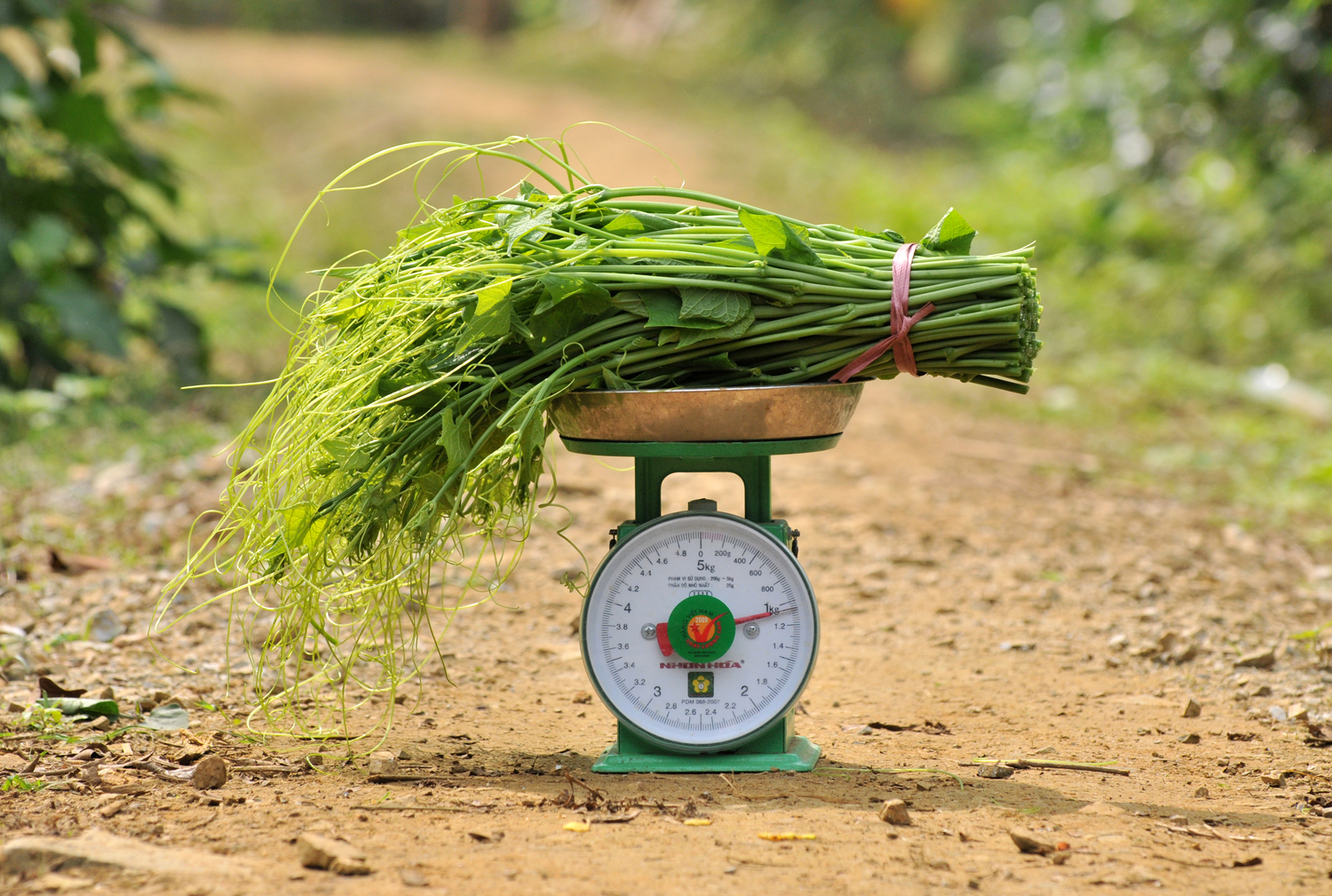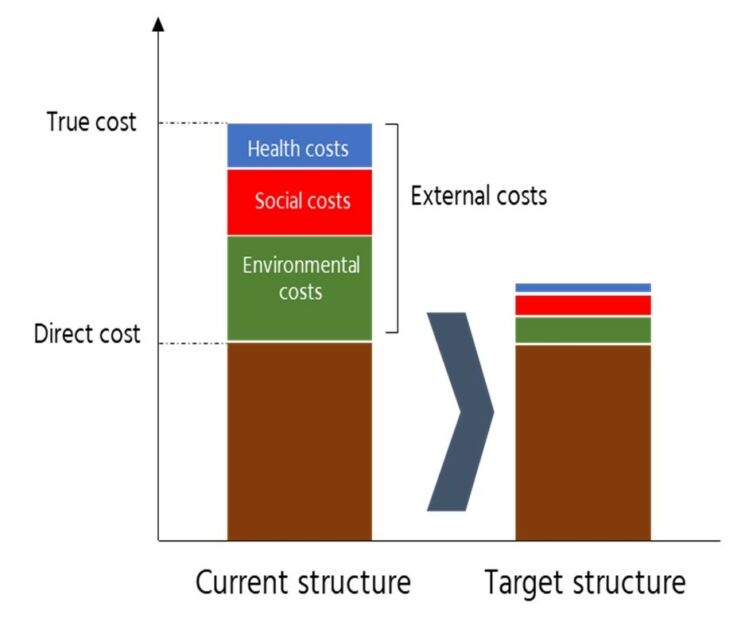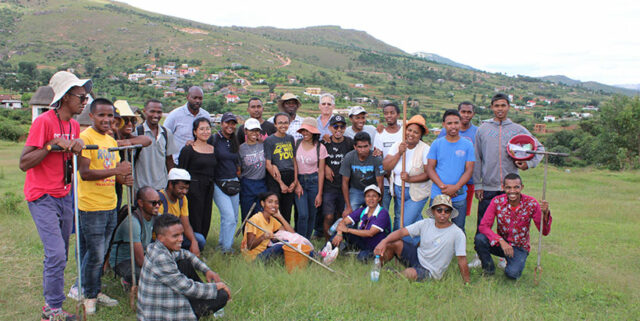
Food prices may be soaring but we’re still not paying the true cost of food. New research by the CGIAR Initiative on Nature-Positive Solutions is generating knowledge that will inform policies and investments to sustainably help countries deal with the environmental and social downsides of food systems without increasing price pressure on food.
By Sean Mattson, CGIAR Initiative on Nature-Positive Solutions (NATURE+)
It doesn’t matter where you live. There is no escaping rising food prices. Assuming you can still find physical ones instead of QR code versions, restaurant menus have telltale stickers with handwritten higher numbers. Supermarket shelves are filling up with packaged food that may appear to be roughly the same price, but with less content, a sneaky practice called shrinkflation. Market headlines report the lowest prices for grains futures in several months, but yearslong trends suggest we’re returning to the time before the mid-2000s market shocks The Economist forebodingly heralded as “The end of cheap food.” The same cheap food that has such significant negative effects on our soils, our biodiversity, our climate and on people’s health is not cheap anymore.
Following global trends, food inflation is finally abating (though it remains stubbornly high) in food-stressed countries like Kenya and Vietnam. But the cumulative impact remains staggering, and income hasn’t grown in step with what the poorest households spend an outsized proportion of their budget on: eating.
Unfortunately, inflation alone doesn’t tell the whole story of how much food costs. Even as prices soar, no one pays true food costs when externalities are factored in. These include environmental costs (deforestation, land degradation, water scarcity, climate change, air pollution, fossil fuel depletion, etc.), human or social costs (child labor, forced labor, wage gaps between women and men, lack of workplace safety), and other disagreeable tradeoffs like dropping out of school to work a struggling farm or leaving home to hope a human smuggler will get you across the Mediterranean Sea or the Sonoran Desert alive.
“Even though food prices are rising globally, the true cost of food is still being paid by the environment and society,” said Carlo Fadda, the leader of the NATURE+ Initiative and a lead researcher at the Alliance of Bioversity International and CIAT. “The good news is that there is now a global recognition that successful food system transformation requires us to reduce these hidden costs. NATURE+ is gathering data to show how this can be done at different levels without increasing household food bills.
“But if we want to reduce rural poverty, farmers need to be paid better, and this could increase food prices. Hence, food prices should be kept under control by redirecting damaging subsidies from production to consumption,” Fadda said.
Cutting costs
True cost accounting, or TCA, is a nascent area of research that aims to tally up a reality-based food bill and present it to consumers and policymakers in hopes that changes will be made. While TCA research has largely been commodity-centric, NATURE+’s TCA work focuses more on the true costs of food systems, which go beyond individual crops. One reason for this is that smallholder farmers generally produce a wide variety of different crops and that externalities vary from one community to another.
Eliminating externalities would be the ideal path forward. If environmental, social and human externalities are reduced, they will become more manageable.
“It’s not just about compensation and remediation for the externalities imposed in the food systems,” said Rui Benfica, a Senior Research Fellow at the International Food Policy Research Institute (IFPRI) and researcher for NATURE+. “It’s about avoiding externalities in the first place, and as they are already incurred, understanding their nature, identifying the right policies that create incentives for economic actors to take up technologies and practices that help minimize external costs, and legislative measures that promote accountability and fairness.”

But first, researchers needed to add things up. Rui and colleagues at NATURE+ recently gathered data for Kenya and Vietnam through far-ranging interviews with agricultural households and farm workers. They also used cross-country data compiled by the Impact Institute, including the Global Impact Database, and monetization factors from the Impact Institute to value externalities monetarily.
The research focused on gathering data on environmental, social and human costs. The results will guide not only policy but also future research: there needs to be clarity on what externalities exist, their magnitude, and a better understanding the data requirements to make well-informed recommendations. The research will also be useful for scaling up TCA research in Kenya, Vietnam and beyond.
“Our initial results will fill key data gaps and point to specific strategies that can lead to policy recommendations in Kenya and Vietnam,” said Kristin Davis of NATURE+ and IFPRI. “These pilot studies are filling true cost accounting gaps that need to be filled for effective policies to be implemented. The research is also designed to encourage more high-resolution TCA research in other countries.”
TCA research is part of the NATURE+ initiative, which aims to help build nature-positive food systems where the environment can be conserved and restored while improving food production. Many places in the countries where the Initiative works – including Burkina Faso, Colombia and India – have great potential for nature-positive agri-food systems. Not incidentally, a transformation to nature-positive food production is one way for farmers to deal with rising food prices: It can increase food production, reduce food production costs, address hunger and nutrition, and reduce exposure to inflationary forces that are beyond their control. Simultaneously, consumers will have access to more nutritious and safer food.
Several TCA studies in recent years illustrate the usefulness of the approach for policy decision-making. One such study focused on the true costs of coffee in Vietnam. The study found that 61% of researched external costs in the coffee supply chain occur during cultivation. Therefore, the authors recommended that it focusing interventions during cultivation. For example, the study showed that to reduce external costs of coffee cultivation in Vietnam, the greatest impact from nature-positive cost-reducing actions could be improving irrigation practices to reduce the use of scare water supplies and streamlining fertilizer use to reduce water pollution, energy use and production costs for farmers.
Answering difficult questions
TCA is a key part of the Initiative’s work on engaging key stakeholders to help create nature-positive food systems by 2030. The engagement work area includes a large focus on research questions, especially those related to gender and cultural norms, policy and tradeoffs.
There is little argument that forced labor, child labor and underpaid labor (which is generally more prevalent for women) are externalities we all want eliminated from our food systems. But what are the associated costs of making food systems fair and equitable? Where would the greater pay for women come from? What would it cost to find adequately paid labor to replace child labor and forced labor? And what are the policy inroads that are palatable to governments that are trying to keep a lid on inflation?
Without adequate policy modification, attaining the reduction and elimination of externalities in food systems will be difficult. Any policy that could drive food prices higher would likely be a non-starter for most governments. And the last thing consumers want right now is even higher food prices.
“We’re trying to identify policy entry points that help governments address the challenges associated with environmental and social impacts. Those include approaches to sustainable agricultural intensification, e.g., training farmers in practices that address the potential hazards of chemical input use on the environment and human health, or rural infrastructure investments and legislation that discourages child labor and provide better economic opportunities,” Benfica said. “We’re also trying to raise awareness about the true environmental and social costs of putting meals on tables while developing ways to diminish the negative impact of externalities and promote sustainable and equitable food systems.”
TCA’s time is now
Despite the challenges, true cost accounting of food is having its moment. NATURE+ and IFPRI are rolling out their TCA research to innovate alongside several new global initiatives. One is The Economics of Ecosystem and Biodiversity (TEEB) framework, which aims to value ecosystems and biodiversity, put their worth in economic terms and provide policy guidance. Another is the True Cost Accounting initiative, launched in 2019.
While global action is required, change will happen first at the community level. This is where NATURE+ comes in. With decades of research, adopted policy recommendations and strong local relationships, CGIAR is well-placed to bring TCA to local contexts that can serve as a starting point for sub-national, national and regional actions to properly account and pay for the true cost of food.
NATURE+’s TCA work is a response to the Food and Agriculture Organization of the United Nations’ report that sustainable food production is possible but that trends are not moving fast enough to achieve the Sustainable Development Goal of Zero Hunger by 2030. The work is aligned with the United Nations Food Systems Summit Scientific Group that, among other priorities, gives special attention to the True Cost and Price of Food.
“A lot of work is left to do but we’re seeing a global response like never before to taking responsibility for the costs that the environment and society bear because of the unsustainable food systems,” Fadda said. “The era of cheap food may be over but perhaps soon it will have ended for the right reasons.”



